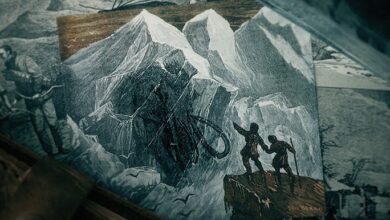Forbidden History the Vatican Does NOT Want You to Know!

The emergence of monsters, demons, and mythical creatures in Christian belief is a surprising story, stemming from a misunderstanding in Bible translation. The Greek word *daimon*, which originally meant “god” or “spirit,” was mistakenly translated as “demon.” Translators of the Bible from Hebrew to Greek used the word to refer to a variety of negative concepts, from pagan gods, to diseases, to monsters and evil creatures. When the word was further translated as “demon,” the concept of “monster hordes” under the rule of Satan began to emerge. This completely changed the understanding of evil forces in Christianity. Previously, Jewish and Christian teachings did not associate demons with Satan or fallen angels. Monsters and “demons” are actually a misinterpretation of the Bible, not an original concept. Combining various elements from biblical passages, such as the fall of Satan from heaven in Luke or the image of “the devil and his angels” in Matthew, has formed the image of Satan as “the king of the demons.” However, it was not until around 300 AD that Christian scholars officially linked Satan with the image of fallen angels from heaven.
In addition, many stories about demons do not appear in the Bible at all, but come from the *Book of Enoch*, a work considered to be outside of mainstream Christian teachings. *The Book of Enoch* tells of fallen angels, called “The Watchers”, who took human children and gave birth to giant creatures – Nephilim, whose souls, after being killed, became demons. Such stories were not only ostracized but were considered “unacceptable” by the Catholic Church.
Another important work that contributed to the formation of the demonic lore was the *Pseudo-Monarchia Daemonum* (roughly translated as “False System of Demons”), written by Johan Weyer in the 16th century. The book was a satire of witch trials and inquisitions, listing 69 known demons of Hell, although Weyer wrote the book with satirical purposes, to counter the unfounded accusations of witchcraft and demons of the time. Names such as Prince Stus, King Balam, Duke Vule or Count Furer became famous figures in folklore and the occult, and Weyer’s book became an important source for demonologists.
One of the demons in this book is the Furer, said to be one of the most powerful demons, ruling over 26 armies of lesser demons. The Furer is described as a vicious liar, but when forced into a magic circle, he is forced to tell the truth. Stories like this, though fictional, have a profound influence and are believed and studied by many.
In addition, one of the interesting and controversial things is that Isaac Newton, famous for his discovery of gravity, was also a researcher of the occult and predicted the end of the world. Newton believed that the prophets’ predictions of the end of the world were baseless theories, and he used science to decipher the stories in the Bible, predicting that the end of the world would not come before 2060. It is worth noting that this document is currently kept at the National Library and Hebrew University in Jerusalem and has no intention of being made public, Newton wanted to carry this secret with him for the rest of his life.
In addition to stories about demons and apocalyptic predictions, there are also strange stories about crimes involving sacred relics. One example is the robbery of the brain of St. Don Bosco in Italy in 2017. The brain was preserved in a glass jar in a basilica in Turin, where pieces of the saint’s brain were kept as a holy relic. However, after being stolen, the brain was never found again. Many speculate that the thieves may have used the brain in satanic rituals.
The story of Warren Jeffs, the leader of the Church of Jesus Christ of Latter-day Saints (FLDS), is one of the most iconic examples of religious perversion. Jeffs, who was convicted of child molestation and leading a polygamist community, continued to run the church from prison, forcing his followers to follow his every command, despite the crimes he committed.
The Columns, decorated with demonic images, were avoided for centuries, feared by all who encountered them. Bishop Basil, who lived from 329 to 379 AD, is a real historical figure central to an intriguing apocryphal tale. With assistance from the Virgin Mary, Basil managed to remove these demonic pillars to build a church dedicated to her. However, once he began his work, he faced resistance from two demon wizards who wanted the columns to remain untouched. The story culminates in a magical battle between Basil, supported by Mary, and the wizards. Ultimately, Basil triumphs, banishing the demons. Two surviving copies of this ancient text are stored in the Lipic University Library and the Vatican’s library, raising the question of what other secret texts might be hidden within the Vatican, possibly concerning demon battles or other supernatural encounters.
Another recently translated text, which also deals with demons, was written around the 11th century but likely based on a much older story, possibly 1600 years old. It recounts a fictional adventure of Saint Peter, in which he encounters a group of angels who don’t seem quite right. Peter quickly realizes they are actually demons disguised as angels. After drawing a protective magic circle and praying to Jesus, the demons reveal their true form. Six of the demons confess to spreading discord among humans, with each demon representing a different vice such as deception, adultery, slander, and greed. One demon, however, questions why demons are treated so harshly by God, while humans are forgiven for their sins. The demon argues that humans are weak and easily tempted and that demons should not be blamed for their faults. Peter, uninterested in engaging in a theological debate, lets the demons go, effectively sidestepping the confrontation. The surviving copy of this text, now housed in the Biblioteca Angelica in Rome, would have been believed as a true account by readers 1600 years ago, reflecting the complex interplay of faith and folklore at the time.
The story of Sister Maria, who allegedly wrote a letter under the influence of the devil, takes us to 1676 in Sicily. Found in her cell, the letter was incomprehensible, filled with strange symbols and characters from various ancient alphabets, making it unreadable to anyone who saw it—Maria herself couldn’t even decipher it. The letter was thought to be the result of possession, as Maria believed she was controlled by a demon when she wrote it. For centuries, the letter remained a mystery until 2017, when Italian scientists cracked its code. They discovered that Maria had written in shorthand, using a combination of runic, Arabic, Greek, and Latin symbols. The deciphered message, which read, “God, Jesus, and the Holy Spirit are dead weights,” was disturbing. While some still believe Maria was possessed, scientists propose that she may have had schizophrenia and a remarkable command of languages, allowing her alternate personality to create the cryptic letter.
The concept of the Trinity in Christianity—Father, Son, and Holy Spirit—is not unique to Christianity but can be found in various ancient religions. For example, Hinduism’s Trimurti consists of Brahma, Vishnu, and Shiva, representing creation, preservation, and destruction, respectively. This suggests that the Christian Trinity may have been influenced by earlier religious models, sparking debates about whether Jesus may have been influenced by Hindu thought during his lifetime.
In 1738, the Catholic Church formally condemned Freemasonry, prohibiting its members from joining, citing the irreconcilable differences between Catholic doctrine and Masonic beliefs. This prohibition was reaffirmed in 2023 with an official Vatican document, which reiterated the incompatibility of Freemasonry with the faith. Pope Clement XII called Freemasonry “depraved and perverted,” a stance that reflects a deep distrust of secret societies. Some speculate that the Vatican’s strong opposition stems from a fear of Freemasonry’s secretive nature, its rituals, and its potential connections to demonic practices. Freemasonry has long been misunderstood, and some even associate it with satanic rituals, though there is no solid evidence for this.
The Ars Goetia, part of the Lesser Key of Solomon, details 72 demons, categorizing them by rank and power. These demons are described as holding various titles such as Kings, Dukes, Princes, and Knights, each with unique abilities. For example, Baal, the greatest of the demon kings, commands 66 legions and can teach invisibility. Ammi, a Duke, controls 29 legions and is depicted with the head of a unicorn. He is associated with thunder and storms. The text also mentions other demon ranks, including princes like Vago, who can show past and future events, and knights like Ferus, who is associated with pyromancy and the stars. These demons are central figures in the Goetia and have captivated occultists and scholars alike for centuries.
This rich tapestry of stories, texts, and mysteries intertwines religion, folklore, and hidden knowledge, pointing to a deeper, often unsettling world of ancient beliefs and hidden truths.








